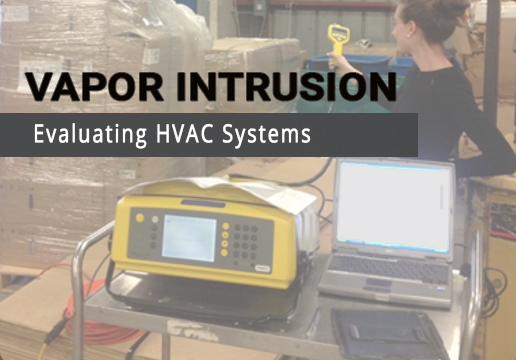This is the third in a series of posts on vapor intrusion, which refers to the migration and entry of volatile organic chemicals (VOCs) into the indoor air of buildings from underlying or nearby contaminated soil or groundwater, resulting in risk to occupant health and safety.
Our previous posts on vapor intrusion (VI) focused on improved assessment methods, including real-time investigations and soil profiling. In this post, we discuss the importance of evaluating a building’s heating, ventilating, and air conditioning (HVAC) system when undertaking a VI assessment.
The main concern with VI is how it can affect indoor air quality. And one of the most important factors affecting indoor air quality is a building’s HVAC system. Many VI assessments fail to consider how the HVAC system may be influencing investigation results. As a consequence, these VI investigations may be missing important pieces to the puzzle to explain how VI is occurring and how it can be mitigated.
HVAC Systems’ Affects on Vapor Intrusion
HVAC systems can play a major role in VI and its mitigation, mainly in commercial and industrial buildings, but they can also be important for certain types of residential buildings and single family homes with active ventilation. Therefore, it is important to engage the assistance of those with HVAC expertise when undertaking a VI assessment in buildings with these systems.
HVAC systems can have both favorable and unfavorable effects on VI, depending primarily on how they effect air pressure and air exchange in the building. Where air is actively being removed from a room, areas of low pressure conducive to VI may be present. These areas typically contain exhaust fans, such as kitchens, cafeterias, rest rooms, laboratories, and certain manufacturing spaces.
On the other hand, where air is being actively delivered to a room, “positive pressure” can potentially prevent subsurface vapors from migrating into the room. Actively ventilated buildings can also reduce the effects of VI on indoor air quality through fresh air exchange.
Vapor Intrusion Mitigation Benefits and Drawbacks
The ability of HVAC systems to influence air pressure and air exchange make them potential candidates to be used for VI mitigation in place of, or in combination with, traditional VI mitigation methods. The potential benefits of using HVAC systems for VI mitigation include:
- Offer “rapid response” to a significant indoor air quality issue caused by VI, until a permanent solution can be implemented
- Existing HVAC equipment may be re-purposed or modified for VI mitigation with less disruption and cost than other mitigation methods
- Building owners/operators are usually already familiar with HVAC systems and how to maintain them
- Typical mitigation methods, such as sub-slab depressurization, may be infeasible for certain older or complex buildings
The drawbacks of using HVAC systems for VI mitigation include:
- May be subject to operating variability or human interference, with resulting loss of effectiveness
- May be subject to neglect and resulting degradation in effectiveness
- May require more energy and higher operating costs compared to traditional mitigation methods
An evaluation of a building’s HVAC system is critical to understanding how a building is affected by VI. Such an understanding will lead to more rapid, effective VI mitigation, whether or not the HVAC system is part of the solution.
For more detailed technical information on the influence of HVAC systems on vapor intrusion, please refer to our white paper available when you complete the form below.
For over two decades, Sanborn Head has been a pioneer and first adopter of improved tools and methods for VI assessment and mitigation. Our VI practitioners have helped develop and promote advanced data collection techniques and mitigation methods through our contributions to the Interstate Technology & Regulatory Council (ITRC) VI guidance, teaching, and scores of presentations, webinars, and papers for environmental conferences and webinars. Beyond technical expertise, we provide our clients with strategic advice and solutions grounded in practical experience.
Posted In: Articles
Tagged In: Vapor Intrusion





